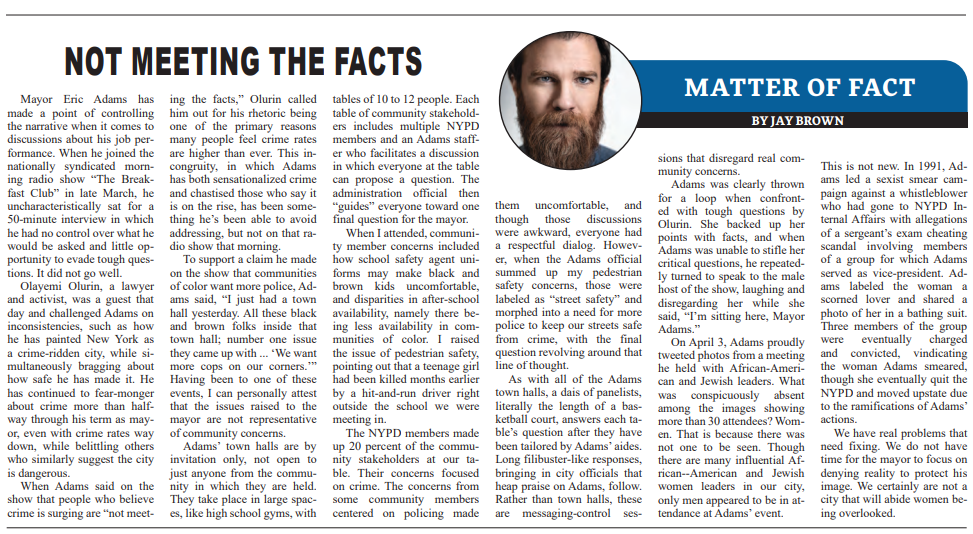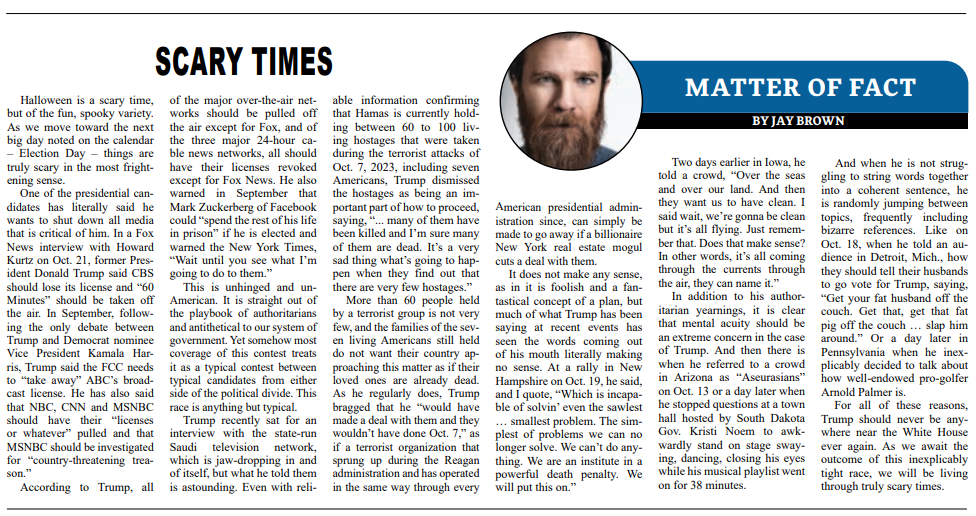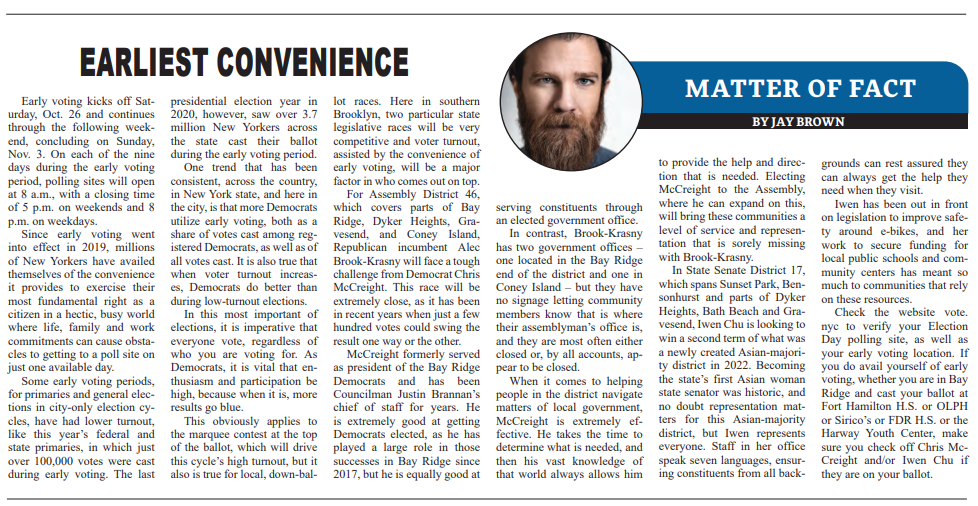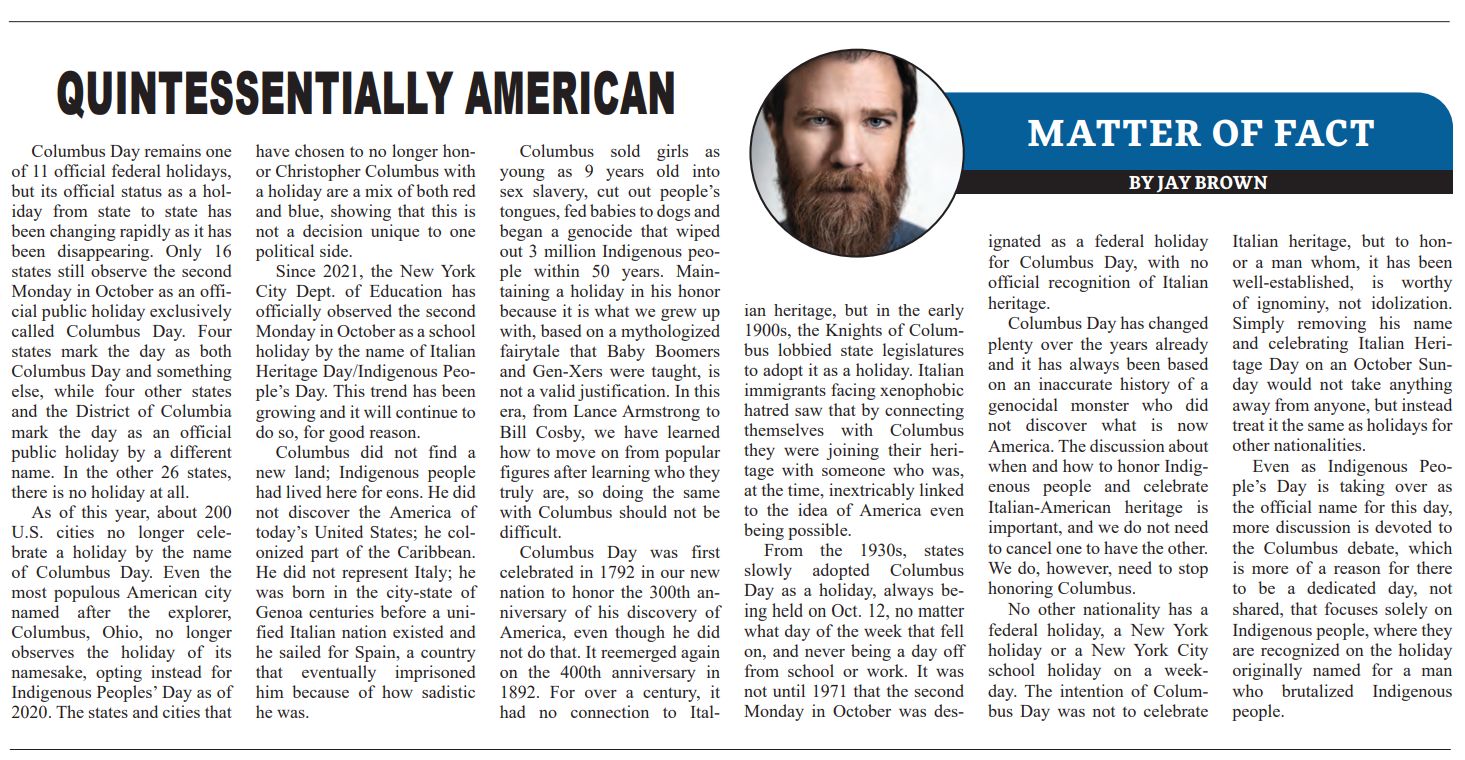
This column, from the weekly opinion piece MATTER OF FACT, first appeared on BrooklynReporter.com, the Home Reporter and Spectator dated April 12, 2024
Mayor Adams has made a point of controlling the narrative when it comes to discussions about his job performance. When he joined the nationally syndicated morning radio show, The Breakfast Club, in late March, he uncharacteristically sat for a 50-minute long interview in which he had no control over what he would be asked and little opportunity to evade tough questions. It did not go well.
Olayemi Olurin, a lawyer and activist, was a guest that day and challenged Adams on inconsistencies, such as how he has painted New York as a crime-ridden city, while simultaneously bragging about how safe he has made it. He has continued to fear-monger about crime more than halfway through his term as mayor, even with crime rates way down, while belittling others who similarly suggest the city is dangerous.
When Adams said on the show that people who believe crime is surging are “not meeting the facts,” Olurin called him out for his rhetoric being one of the primary reasons many people feel crime rates are higher than ever. This incongruity, in which Adams has both sensationalized crime and chastised those who say it is on the rise, has been something he’s been able to avoid addressing, but not on that radio show that morning.
To support a claim he made on the show that communities of color want more police, Adams said, “I just had a town hall yesterday. All these black and brown folks inside that town hall; number one issue they came up with… ‘We want more cops on our corners.’” Having been to one of these events, I can personally attest that the issues raised to the mayor are not representative of community concerns.
Adams’ town halls are by invitation only, not open to just anyone from the community in which they are held. They take place in large spaces, like high school gyms, with tables of ten to twelve people. Each table of community stakeholders includes multiple NYPD members and an Adams staffer who facilitates a discussion in which everyone at the table can propose a question. The administration official then “guides” everyone toward one final question for the mayor.
When I attended, community member concerns included how school safety agent uniforms may make black and brown kids uncomfortable, and disparities in after-school availability, namely there being less availability in communities of color. I raised the issue of pedestrian safety, pointing out that a teenage girl had been killed months earlier by a hit-and-run driver right outside the school we were meeting in.
The NYPD members made up 20 percent of the community stakeholders at our table. Their concerns focused on crime. The concerns from some community members centered on policing made them uncomfortable, and though those discussions were awkward, everyone had a respectful dialog. However, when the Adams official summed up my pedestrian safety concerns, those were labeled as “street safety” and morphed into a need for more police to keep our streets safe from crime, with the final question revolving around that line of thought.
As with all of the Adams town halls, a dais of panelists, literally the length of a basketball court, answers each table’s question after they have been tailored by Adams’ aides. Long filibuster-like responses, bringing in city officials that heap praise on Adams, follow. Rather than town halls, these are messaging-control sessions that disregard real community concerns. Adams was clearly thrown for a loop when confronted with tough questions by Olurin.
She backed up her points with facts, and when Adams was unable to stifle her critical questions, he repeatedly turned to speak to the male host of the show, laughing and disregarding her while she said, “I’m sitting here, Mayor Adams.”. On April 3, Adams proudly tweeted photos from a meeting he held with African American and Jewish leaders. What was conspicuously absent among the images showing more than 30 attendees? Women. That is because there was not one to be seen. Though there are many influential African American and Jewish women leaders in our city, only men appeared to be in attendance at Adams’ event.
This is not new. In 1991, Adams led a sexist smear campaign against a whistleblower who had gone to NYPD Internal Affairs with allegations of a sergeant’s exam cheating scandal involving members of a group for which Adams served as vice-president. Adams labeled the woman a scorned lover and shared a photo of her in a bathing suit. Three members of the group were eventually charged and convicted, vindicating the woman Adams smeared, though she eventually quit the NYPD and moved upstate due to the ramifications of Adams’ actions.
“The way we treated Ms. Lebron during that [cheating scandal] was wrong, and I regret that it happened.”
Then-mayoral candidate Eric Adams when asked on October 19, 2021 about his part in sexist smear campaign 30 years earlier against NYPD whistleblower whose allegations were later validated by criminal convictions
We have real problems that need fixing. We do not have time for the mayor to focus on denying reality to protect his image. We certainly are not a city that will abide women being overlooked.



